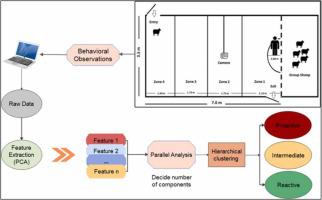Behavioural Processes ( IF 1.3 ) Pub Date : 2021-11-25 , DOI: 10.1016/j.beproc.2021.104559 Cihan Çakmakçı 1

|
The objective of this study was to define coping style of sheep by using unsupervised machine learning approaches. A total of 105 Norduz sheep (age 3–5 years) were subjected to a 5-minute arena test. Agglomerative Hierarchical Clustering (HCA) was performed on scores of selected principal components retained from Principal Components Analysis (PCA) on arena behaviors to identify sheep coping style. Initially, the variables retained for the PCA were determined with Bartlett’s test for sphericity and Kaiser-Meyer-Olkin (KMO) measure of sample adequacy. Seven behavioral variables with KMO values greater than 0.5 were used for final PCA: the average distance to group sheep (DTG), the average distance to stimulus (DTS), the duration of locomotion (LOC), the total number of zone boundaries crossed during the test (CRS), the total number of times that tested sheep sniffed stimulus (NSS), latency to the first sniff the stimulus (LSS), and subjective scores (SCR) scored by an observer on a scale from 1 to 5 (1: extremely calm, 5: extremely restless). The first two components, which were the only ones with an eigenvalue greater than one, accounted for 70.32% of the total variation and were used for clustering analysis. Clustering tendency showed that the scores for the first two components were suitable for clustering (Hopkins' H = 0.852). Several cluster validity indexes were used to obtain aggregated results to determine the most appropriate clustering method and number of clusters. Five different clustering methods: k-means and hierarchical clustering with Ward, average, single and complete linkage were compared. Bootstrap resampling was used to evaluate the stability of a given cluster using the Jaccard coefficient. The clustering method and number of clusters corresponding to the highest rank aggregation score from the bootstrap resampling indicate that the hierarchical clustering method with average linkage and 5 clusters is the most suggested clustering method. However, Ward's algorithm identified the strongest clustering structure for hierarchical clustering, as it had the highest agglomerative coefficient value (0.98). When both Jaccard and aggregation scores are considered together, Ward’s method with 3 clusters was selected as the most appropriate method. Sheep were classified into three coping styles (CS) based on HCA results as reactive (Cluster 1, n = 71), intermediate (Cluster 2, n = 22) or proactive (Cluster 3, n = 12). Coping style had significant effect on behavioral variables, DTG, DTS, LOC, CRS and NSS (P < 0.05). The individuals that have proactive coping style had the highest mean values for the variables DTG, DTS and LOC and SCR (P < 0.0001). This indicates that proactive sheep are more active then reactive sheep. The CRS, LOC and NSS mean values were higher for intermediate sheep compared to reactive sheep (P < 0.05). The NSS values were higher for intermediate sheep compare to proactive sheep (P < 0.0001). The findings of the current study show that distinct coping styles in sheep may be identified based on behaviors recorded in an arena test. The findings also revealed that sheep's coping style can be objectively identified by unsupervised machine learning from unlabeled behavioral data.
中文翻译:

绵羊的应对方式可以通过未标记数据的无监督机器学习来识别
本研究的目的是通过使用无监督机器学习方法来定义绵羊的应对方式。共有 105 只 Norduz 绵羊(3-5 岁)接受了 5 分钟的竞技场测试。对从主成分分析 (PCA) 中保留的选定主成分的分数执行凝聚层次聚类 (HCA),以识别绵羊的应对方式。最初,保留用于 PCA 的变量是通过 Bartlett 球形检验和 Kaiser-Meyer-Olkin (KMO) 样本充分性测量来确定的。KMO 值大于 0.5 的七个行为变量用于最终的 PCA:到群羊的平均距离 (DTG)、到刺激的平均距离 (DTS)、运动持续时间 (LOC)、期间跨越的区域边界总数测试(CRS),测试绵羊嗅刺激的总次数 (NSS)、第一次嗅刺激的潜伏期 (LSS) 和观察者在 1 到 5 的范围内评分的主观评分 (SCR)(1:非常平静,5:极度不安)。前两个分量是唯一特征值大于 1 的分量,占总变异的 70.32%,用于聚类分析。聚类趋势表明前两个分量的分数适合聚类(Hopkins' H = 0.852)。几个聚类有效性指标被用来获得聚合结果,以确定最合适的聚类方法和聚类数量。对五种不同的聚类方法:k-means 和带有 Ward 的层次聚类、平均、单一和完全链接进行了比较。Bootstrap 重采样用于使用 Jaccard 系数评估给定集群的稳定性。bootstrap 重采样的最高秩聚合分数对应的聚类方法和聚类数表明,平均链接和 5 个聚类的层次聚类方法是最推荐的聚类方法。然而,Ward 的算法为层次聚类确定了最强的聚类结构,因为它具有最高的凝聚系数值 (0.98)。当同时考虑 Jaccard 和聚合分数时,具有 3 个聚类的 Ward 方法被选为最合适的方法。根据 HCA 结果,绵羊被分为三种应对方式 (CS),即反应性(集群 1,n = 71)、中间(集群 2,n = 22)或主动(集群 3,n = 12)。应对方式对行为变量DTG、DTS、LOC、CRS和NSS有显着影响(P < 0.05)。具有主动应对方式的个体在变量 DTG、DTS、LOC 和 SCR 方面的平均值最高(P < 0.0001)。这表明主动羊比被动羊更活跃。与反应性绵羊相比,中间绵羊的 CRS、LOC 和 NSS 平均值更高(P < 0.05)。与主动羊相比,中间羊的 NSS 值更高(P < 0.0001)。当前研究的结果表明,可以根据竞技场测试中记录的行为来识别绵羊不同的应对方式。研究结果还表明,绵羊的应对方式可以通过无监督机器学习从未标记的行为数据中客观地识别出来。LOC、CRS 和 NSS(P < 0.05)。具有主动应对方式的个体在变量 DTG、DTS、LOC 和 SCR 方面的平均值最高(P < 0.0001)。这表明主动羊比被动羊更活跃。与反应性绵羊相比,中间绵羊的 CRS、LOC 和 NSS 平均值更高(P < 0.05)。与主动羊相比,中间羊的 NSS 值更高(P < 0.0001)。当前研究的结果表明,可以根据竞技场测试中记录的行为来识别绵羊不同的应对方式。研究结果还表明,绵羊的应对方式可以通过无监督机器学习从未标记的行为数据中客观地识别出来。LOC、CRS 和 NSS(P < 0.05)。具有主动应对方式的个体在变量 DTG、DTS、LOC 和 SCR 方面的平均值最高(P < 0.0001)。这表明主动羊比被动羊更活跃。与反应性绵羊相比,中间绵羊的 CRS、LOC 和 NSS 平均值更高(P < 0.05)。与主动羊相比,中间羊的 NSS 值更高(P < 0.0001)。当前研究的结果表明,可以根据竞技场测试中记录的行为来识别绵羊不同的应对方式。研究结果还表明,绵羊的应对方式可以通过无监督机器学习从未标记的行为数据中客观地识别出来。具有主动应对方式的个体在变量 DTG、DTS、LOC 和 SCR 方面的平均值最高(P < 0.0001)。这表明主动羊比被动羊更活跃。与反应性绵羊相比,中间绵羊的 CRS、LOC 和 NSS 平均值更高(P < 0.05)。与主动羊相比,中间羊的 NSS 值更高(P < 0.0001)。当前研究的结果表明,可以根据竞技场测试中记录的行为来识别绵羊不同的应对方式。研究结果还表明,绵羊的应对方式可以通过无监督机器学习从未标记的行为数据中客观地识别出来。具有主动应对方式的个体在变量 DTG、DTS、LOC 和 SCR 方面的平均值最高(P < 0.0001)。这表明主动羊比被动羊更活跃。与反应性绵羊相比,中间绵羊的 CRS、LOC 和 NSS 平均值更高(P < 0.05)。与主动羊相比,中间羊的 NSS 值更高(P < 0.0001)。当前研究的结果表明,可以根据竞技场测试中记录的行为来识别绵羊不同的应对方式。研究结果还表明,绵羊的应对方式可以通过无监督机器学习从未标记的行为数据中客观地识别出来。与反应性绵羊相比,中间绵羊的 LOC 和 NSS 平均值更高(P < 0.05)。与主动羊相比,中间羊的 NSS 值更高(P < 0.0001)。当前研究的结果表明,可以根据竞技场测试中记录的行为来识别绵羊不同的应对方式。研究结果还表明,绵羊的应对方式可以通过无监督机器学习从未标记的行为数据中客观地识别出来。与反应性绵羊相比,中间绵羊的 LOC 和 NSS 平均值更高(P < 0.05)。与主动羊相比,中间羊的 NSS 值更高(P < 0.0001)。当前研究的结果表明,可以根据竞技场测试中记录的行为来识别绵羊不同的应对方式。研究结果还表明,绵羊的应对方式可以通过无监督机器学习从未标记的行为数据中客观地识别出来。











































 京公网安备 11010802027423号
京公网安备 11010802027423号